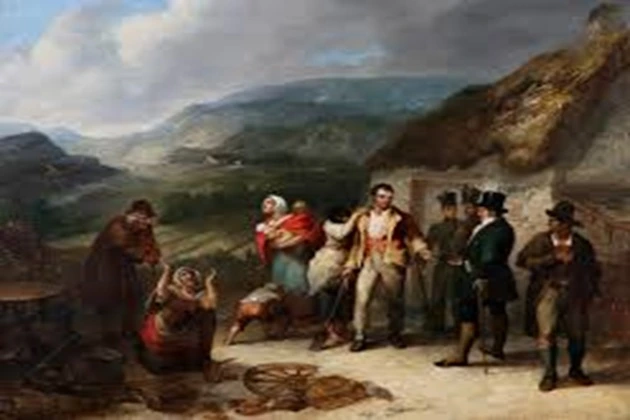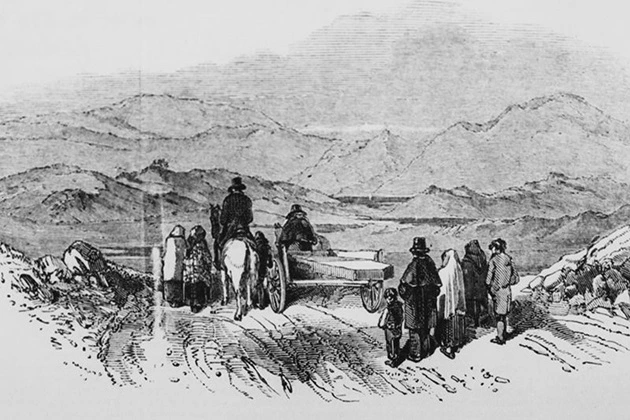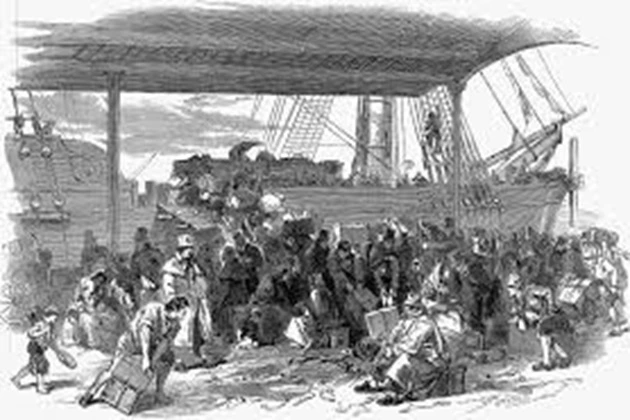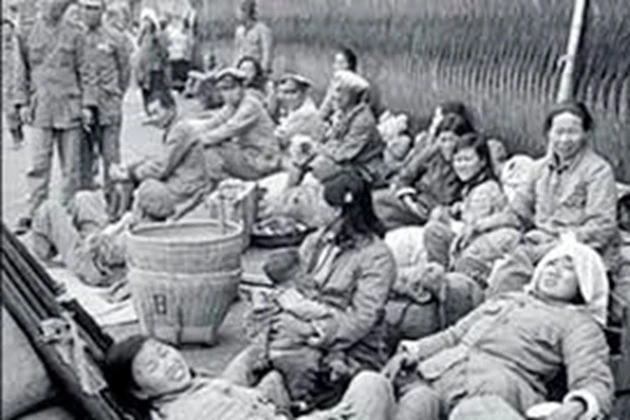The Great Famine: how Ireland lost a quarter of its population

The period from 1846 to 1851, known as The Great Famine or the ‘Potato Famine,’ was a time of profound tragedy. The Irish refer to these years as the word Drochshaol, which translates to ‘a bad life’ or ‘hard times,’ a description that captures the true nature of the events. Hunger was the island’s primary, but not sole, issue. The exact death toll remains unknown, adding to the tragedy of this period.
According to the most conservative estimates, we are talking about 700,000 people. Some historians believe that the death rate exceeded one and a half million. The figures are impressive without any context, but the picture becomes much more gloomy if you consider the total population of Ireland. On the eve of the famine, only 8.5 million people lived there.
However, that’s not all. “Hard times” provoked mass emigration, the scale of which is estimated at two million people. Large cities emptied, and small villages disappeared. Ireland still cannot get out of this demographic hole.
How could this happen, especially in Ireland, which was not only part of the richest British Empire but also located near the capital? Are the Irish really that lazy and wild? Maybe they angered God somehow, or was it all the fault of London politics? Usually, significant and tragic events have several causes. This story is no exception, so let’s start with some background — land reform.
The land and its owners

Throughout the Middle Ages, Ireland had a clan system that dates back to ancient times. All the lands belonged to different septs—that was the name of the traditional unit of society. One clan could include several septs with different surnames but with a certain degree of kinship. In such a system, the King of Ireland played a rather symbolic role, although, like representatives of other clans, he had his lands. Constant internecine strife did not contribute to strengthening statehood, which the only neighbor noticed.
Already in the XVI century, Ireland adopted English common law. Some local nobility were bought, and the incorruptible or too-expensive ones were forced to flee to Europe. By the middle of the 17th century, the English authorities in Dublin had, for the first time, established centralized control over the entire island. Lands previously owned by “wild” chiefs, septs, and clans were divided in a new way between “noble” lords, earls, and sirs. A series of invasions preceded such a grandiose redistribution, as they would call it today — an expensive creeping occupation. Now, it’s time to rule wisely and make money. A new class of Irish landowners prefer to live in London.
In the 18th century, Parliament approved a land reform allowing property to be managed through intermediaries. The classic “landlord” appeared in his provincial possessions once every few years, or he might not visit the island at all in his entire life. The local nobility was in charge of regional affairs. The system is straightforward. A wealthy middleman rented large plots of land for a long time and for a fixed price. After that, he cut them into small, sometimes tiny pieces and sublet them to individual peasant families (usually for one season, after which conditions could change).
A simple process increased the total cost of rent significantly.
The difference went into the pocket of the intermediary, who had the main interest in making the most profit. The landowner pursued precisely the same goal. The most vulnerable side of the deal turned out to be a simple man working directly on the ground with his own hands.
Wise men who sat in the English Parliament for years lamented the Irish’s lack of initiative: How can you live in such bestial conditions? A hut made of rotten planks, a bed with a blanket — an attribute of luxury. For breakfast, lunch, and dinner — potatoes. Is this the limit of dreams for a peasant? This opinion was widespread; the Irish were perceived as second-rate people, not entirely civilized. From the outside, especially from London, it might seem so, but let’s look at the sublease conditions.
The meaning of potatoes

In the XVII century, potatoes were brought to the island. At first, it served as an additional food to milk, butter, and more traditional cereals. During the Napoleonic Wars and the continental blockade of Britain, the demand for food increased dramatically. The peasants had access to only small plots, which they sublet. Therefore, unpretentious potatoes, capable of proliferating and even in a relatively small space, have become the basis of the diet. Most of the lower class lived exclusively on potatoes, especially in winter.
Moreover, the agricultural economy has formed a system of “potato wages.” Food was paid for wage labor on the same farms. Each tenant allocated a piece of land where he grew potatoes for himself for the winter and as a “currency.” Such a monoculture seemed like a simple solution, but an unexpected problem arose. The Irish Lumper variety accounted for a disproportionately large proportion of potatoes grown in Ireland.
This created a lack of genetic variability and caused vulnerability to diseases. In the early 1840s, potato crops were infected with the pathogenic microorganism Phytophthora infestans. The epidemic also spread across continental Europe, where about 100,000 people died of starvation, which was one of the reasons for the “Spring of the Peoples” — a series of revolutions and uprisings against monarchies. However, various crops, including potatoes, were better on the continent. A Great famine began when the infection reached an isolated island with a disenfranchised and impoverished population.
The black 47th

The first reports of infection appeared in 1845. A delegation from Dublin is seeking a meeting with the English governor, Lord Heytesbury. The proposals were clear and reasonable: to open ports for the import of foreign corn, to ban the export of food from Ireland, and to provide employment through the organization of public works. The issue of the widespread implementation of the “tenant’s right,” as it was in the already mentioned Ulster, was also raised. The internal Parliament of Ireland probably would have accepted the proposals, but it did not exist. Lord Heytesbury considered the panic premature and called for the abandonment of excessive drama, referring to the investigation already conducted by scientists and economists from London.
John Mitchell is a famous political figure of his era, an Irish nationalist or a patriot. According to the law “On Treason” adopted in the same year, he was accused of sedition and exiled to Bermuda. He was the first to consider the Great Famine as a deliberate attempt at genocide.
The conclusion is not without logic, but rather several factors, including the lack of professionalism of the governing bodies, slowness in decision-making, and, of course, corruption. In 1846, the first starvation deaths were recorded. Horror covers Ireland, but there is hope for the future harvest, which will die almost completely.
Against this background, London is betting on the market, choosing the path of non-interference. That is, it does not change the food import and export order. Thousands of tons of food are still being exported from starving Ireland. Sir Charles Trevelyan will point out that the Irish are too poor to buy food. Therefore, supplies will flow to the island like a river after people have money. To speed up the process, community service was organized with free canteens. They also adopted the law “On the Poor,” which provides small benefits.
It should be noted that these words also make sense; only the expected effect could come a few years later. People needed help right now. Therefore, let’s return to the benefits, which in many ways aggravated the situation. The “Gregory Amendment” was adopted by the law and named after the initiator, Sir William Gregory. The link prohibited anyone who owned a plot of 0.1 hectares or more from receiving benefits. In practice, this meant that most peasants, forced to give the entire harvest as rent, could not count on subsidies.
In addition, landlords were required to pay contributions for each small farmer whose annual rate did not exceed 4 pounds sterling. Such a tax was planned to improve the sponsorship of free canteens and collect more humanitarian aid. In reality, mass evictions of the poorest farmers have begun. It has become more profitable for landowners to look for large tenants so as not to pay any dues. We came close to the main problem, which was rotten morality.
1847 was called black — this year, a record death rate was recorded, which was caused mainly by the eviction of a huge number of poor peasants. In addition to forced eviction, there was a conditionally voluntary one, when the landowner paid a small compensation or resorted to deception, sending the unfortunate to non-existent community work, where there would be no free canteen for the whole family.
Historians believe we are talking about 250-300 thousand people left on the street without money, housing, or work. Let’s look at some documented evidence. In 1847, the Mahon family evicted more than 3,000 people, attributing this to their plight, although the lobster soup was still on their dining table.
Earl George Bingham, who owned 240 square kilometers of land, became the record holder for eviction, signing the death sentence of thousands of Irish people. The count did not want to breed beggars and pay priests. Another major landowner, the Marquess of Sligo, said he was trying to be selective, getting rid only of the idle and dishonest. Exactly a quarter of the total number of tenants was such, all from the poorest strata.
Causes of death

The “Gregory Amendment” alone from 0.1 hectares became a death sentence for tens of thousands of people. The widespread practice of eviction one day outlawed humanism. When a house is burned down right in front of your eyes, you have to accept your fate or take up arms. Over ten large landowners faced revenge and did not survive the Great Famine. Fearing the spread of the rebellion, London sent additional troops to Ireland. Many historians believe that it was then that the point of no return was passed. Irish folklore will forever imprint the details of the Great Famine in people’s memory.
Researchers agree that about a million people died in five years, most of them from diseases caused by hunger. Even a simple flu turns out to be deadly for a weakened body. What can we say about smallpox or cholera, which also visited the island during the “hard times”? Two million more people have left the country. So, Ireland lost a quarter of its population. It is worth noting that not all landlords and representatives of the English administration silently and indifferently watched the tragedy of an entire nation.
The Prime Minister, Sir Robert Peel, secretly bought 100,000 pounds of corn from the United States and sent it to Ireland. This act will partly cost him his position. Some landowners will pay out of their pockets for seats on merchant and passenger ships that sail to the New World and are the last hope of disadvantaged farmers.
On his initiative, rear Admiral of the Royal Navy Hugh Pigot will oversee the logistics of delivering humanitarian aid using warships. He also ordered the deployment of military hospitals and did not spare the scarce medicines that were needed most in Ireland, the world’s largest country.
In addition, the military will take care of the burials of the dead. However, for every Peel or Pigot, there are a dozen indifferent officials.
A memorial has been erected in the Doolagh Valley for those who died on the Hunger March. A representative of the administration was supposed to arrive in Louisburgh to find out who from the locals needed food assistance, but for some reason, stopped at a residence more than twenty kilometers from the city. Exhausted citizens were instructed to report to the inspector themselves. Not everyone reached the residence, and even fewer returned home.
The big exodus

The exodus was genuinely massive – from 300,000 to 500,000 people annually. Such figures are explained by one feature that is atypical for world history. About the same number of women left the country with men. For young people, it has become a rite of passage into adulthood. During the “hungry years,” about 5,000 ships with passengers crossed the Atlantic, sometimes called floating coffins. Such a trip cannot be called comfortable or at least safe.
Many ships have long since exhausted their resources and were not designed to transport people. For weeks, people were in cramped, unsanitary conditions and with a minimal supply of food. About 15% died before reaching America. If he was lucky, the young immigrant arrived in the USA or Canada, where he took on any job with only one goal — to earn money for another ticket for his relative who remained in Ireland.
Soon, the Irish settled on the East Coast of the United States, which provoked a fierce conflict with the locals, who called themselves Native Americans. This story is perfectly reflected in the film “Gangs of New York” – reconsider, then perhaps you will notice new details, for example, how much a plate of soup and a slice of bread meant to a man going ashore. Why was he willing to cast his vote and even go to war for a seemingly insignificant offering? As of today, more than 34 million Americans have full or partial Irish ancestry.




